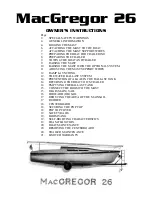
EMERGENCIES
Fire/Explosion
Many boat fires involve flammable liquids such as gas or
oil. Many inboard fires start in the bilge area which at times
can be filled with gas vapors. Since gas vapors cannot be
seen, boat fires tend to travel very fast. If you encounter a
fire on board, turn off the engine immediately. If you have
a fire extinguisher on board and access to the fire, it may
be controllable. Direct the contents of the extinguisher at
the base of the flames. Throw burning materials overboard
if possible. Put on PFDs, if not already on, signal for help
and prepare to abandon the boat if necessary.
Capsizing and Swamping
A boat may capsize or swamp when least expected.
Formulate a plan in advance on what to do if it should
happen. Keep in mind the following guidelines:
Try to turn the engine OFF to prevent damage.
If others were on board, try to locate them, make sure they
are conscious and that they can swim.
Immersion in water speeds the loss of body heat and can
lead to hypothermia. This is the abnormal lowering of
internal body temperature.
BOATING SAFETY
SECTION 2
2-27
If a leak is discovered, immediately determine the cause.
A collision with an underwater object could cause the hull
to develop a leak. A loose fitting hose clamp on a piece
of equipment could cause a leak. Try to repair the leak if
possible. If a leak is threatening the safety of you and your
passengers, call or signal for assistance.
Staying Afloat
Remain calm. Do not thrash about or try to remove clothing
or footwear. This leads to exhaustion and increases the loss
of air that may keep you afloat.
Keep your life jacket (PFD) on.
Keep your knees bent.
Float on your back and paddle slowly to safety.
Collisions
If a collision occurs, immediately account for all passengers.
Assess the hull for damage and activate the bilge pumps to
reduce any water intake. Try to operate the boat to keep
the damaged area above water. If necessary, call or signal
for assistance.
Grounding
In the event you run aground, assess the situation before
proceeding. Immediately stop any water from entering the
boat. Inspect the rudder and rudder control system, the
hull, propeller and strut for damage. Maneuver the boat to
safe water only if the hull and all operating systems are in
satisfactory operating condition. Otherwise, call or signal
for assistance.
2-28
Содержание 2015 ASR
Страница 1: ...2015 OWNER MANUAL ...
Страница 4: ...SECTION 1 ...
Страница 14: ...INTRODUCTION 1 19 SECTION 1 EUROPEAN SEATING CHART 1 20 ...
Страница 15: ...1 21 1 22 ...
Страница 16: ...1 23 1 24 ...
Страница 17: ...SECTION 2 ...
Страница 46: ...SECTION 3 ...
Страница 60: ...SECTION 4 ...
Страница 74: ...SECTION 5 ...
Страница 80: ...BOAT SYSTEMS SECTION 5 5 11 5 12 ...
Страница 81: ...SECTION 6 ...
Страница 96: ...TROUBLESHOOTING SERVICE REQUIREMENTS SECTION 7 ...
Страница 98: ...TROUBLESHOOTING SERVICE REQUIREMENTS SECTION 7 7 3 7 4 ...
Страница 99: ...TROUBLESHOOTING SERVICE REQUIREMENTS SECTION 7 7 5 7 6 ...
Страница 100: ...TROUBLESHOOTING SERVICE REQUIREMENTS SECTION 7 7 7 7 8 ...
Страница 101: ...TROUBLESHOOTING SERVICE REQUIREMENTS SECTION 7 7 9 7 10 ...
Страница 102: ...TROUBLESHOOTING SERVICE REQUIREMENTS SECTION 7 7 11 7 12 ...
Страница 103: ...TROUBLESHOOTING SERVICE REQUIREMENTS SECTION 7 7 13 ...
Страница 104: ...WARNING LABELS SECTION 8 ...
Страница 107: ...WARNING LABELS SECTION 8 8 5 8 6 ...
Страница 108: ...WARNING LABELS SECTION 8 8 7 8 8 ...
Страница 109: ...WARNING LABELS SECTION 8 8 9 8 10 ...
Страница 110: ...WARNING LABELS SECTION 8 8 11 8 12 ...
Страница 111: ...WARNING LABELS SECTION 8 8 13 8 14 GOOD BAD ...
















































